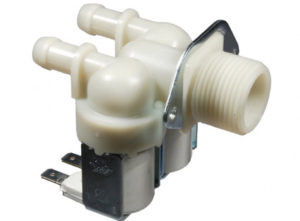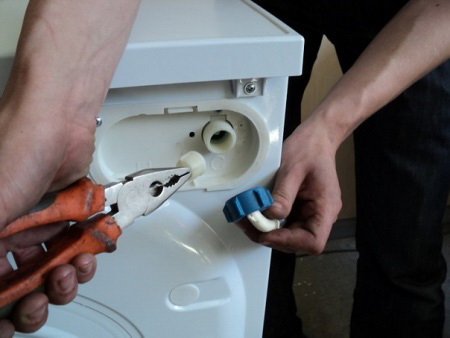 IN modern washing machines There is a very important and necessary part responsible for supplying water to the machine. This is the inlet valve of the washing machine. If it breaks, there is a possibility flooding of the apartment and neighbors of the lower floors. What valves are used in modern washing units, as well as their design and repair will be discussed in detail in this article. Since this device is designed to fill water into the machine, it has another name - fill valve.
IN modern washing machines There is a very important and necessary part responsible for supplying water to the machine. This is the inlet valve of the washing machine. If it breaks, there is a possibility flooding of the apartment and neighbors of the lower floors. What valves are used in modern washing units, as well as their design and repair will be discussed in detail in this article. Since this device is designed to fill water into the machine, it has another name - fill valve.
Purpose and device
The principle of operation of the intake valve is based on the laws of electromagnetism. Therefore, it is often called electromagnetic. The command to supply water is carried out by applying voltage to the coil. A magnetic field is formed around it, which draws in a core made of metal, called a rod. Due to this, a small hole located in the center of a special elastic membrane opens, and water rushes into the dispenser, washing away the powder intended for washing.
Once the required volume of water has been collected, a special sensor will operate. Voltage will stop flowing to the coil. A special spring will work, which will return the rod to its original position and the water supply to the machine will stop.When the intake valve is de-energized, the spring reliably presses the core, closing the diaphragm hole.
Solenoid intake valves come in three types and can have:

- One reel. It is mainly used in washing machines of outdated models. In these devices, the water jet is controlled mechanically using a command device. Water flows into the dispenser using a lever.
- Two coils. Used in modern models of washing machines. Control is carried out electronically. A special module is provided for this purpose. Each individual coil is responsible for supplying water to a specific section of the dispenser. When two coils are turned on simultaneously, the water flow will be directed to the third section of the dispenser.
- Three coils. Just like the previous version, they are used in modern washing machines. They use a dispenser with three compartments. A distinctive feature of this type from the previous one is that, due to the third coil, it is possible to direct the flow of water into the third compartment of the dispenser.
Intake Valve Check
To fully check this part, you need to remove it from the washing machine. It is usually located at the top of the back wall. Except in cases where laundry is loaded vertically. In this case, the inlet solenoid valve is located at the bottom of the structure, also on the rear wall.

Its performance can be checked by alternately applying voltage to the coils, having previously connected water hose. If it is working properly, the open inlet valve will allow water to flow freely. When the current supply to the coils stops, it will close and the water supply will stop.You need to take care of the container into which the water will be drained.
Possible faults
The following malfunctions may occur:
- Filter mesh clogged. It must be carefully inspected and, if necessary, cleaned of dirt and rinsed with water.
- The coils should be checked for serviceability. If voltage is applied to them, but the valve is still in the closed state, then a break is possible. Or the part burned out. A multimeter will help diagnose such a malfunction. The device is switched on in resistance measurement mode and connected to the ends of the coil. The serviceability of the part will be indicated by a resistance of 2 - 4 kOhm.
- Definitely a must check the plastic inserts in the fittings, restraining the pressure of water; if they are broken or missing, the part must be replaced.
Repairing the inlet solenoid valve is most often not possible, since it is a non-separable part that requires complete replacement in case of malfunction. Although some craftsmen replace a failed coil with a serviceable one, if available.
The best option in this case would be to purchase a new intake solenoid valve, and subsequently install it in washing machine.
Valve replacement
- First of all, the washing machine must be disconnected from the power supply and the water turned off. Then remove the back wall.
- All hoses and wires are disconnected from the inlet valve. Whatever you forget, where it goes, it’s better to write it down, sketch it or take a picture.
- Then the valve is released from the fasteners.The bolts that secure it are unscrewed or the latches are bent. They also have a place in some models.
- In order to remove the valve, it must be turned.
- Installation of the intake valve is carried out in reverse order.









